Pronoun: Definition, Meaning and Types Explained (with examples)

What Are Pronouns?
A pronoun is a word that replaces a noun. It’s what you use in a sentence when you want to avoid repetition and make it easier for your readers to understand what you’re trying to say.
There are over 100 pronouns. The most common ones are it, I, you, he, they, we, and she.
A pronoun is an important part of speech. If you use it well, your writing will be richer and more concise.
Pronouns still confuse many people, especially those who don’t understand the different types and the correct grammar rules. So, in this easy-to-understand guide, we’ll discuss what pronouns are and how they work.
Let’s roll!
Pronouns: A Fun Overview

Pronouns substitute nouns to make sentences concise and easy to read. There are nine different types of pronouns that we’ll discuss in this guide.
Sentences without pronouns are awkward and repetitive. Here’s an example:
- John stared at John’s dirty car. John’s car needed a thorough clean. So, John took John’s car to John’s favorite car wash.
Boring, right? Let pronouns come to the rescue. Here’s the concise and more interesting version of the same paragraph with the pronouns in bold:
- John stared at his dirty car. It needed a thorough clean. So, he took it to his favorite car wash.
Lo and behold! See what those little superhero pronouns have done. They’ve made the paragraph so juicy and snackable. With a swift karate kick, pronouns have knocked down the characters in the paragraph from 128 to 104. In addition, the pronouns have punched boredom in the face by removing the weird repetition of the words John and John’s car.
Yes, pronouns make paragraphs short and sweet. You can call them noun substitutes or dummy subjects. They replace what would otherwise be the subject, object, or indirect object of what we are talking about—just as we’ve replaced John with he.
Now, let’s check out the different types of pronouns.
Different Types of Pronouns
1. Demonstrative Pronouns
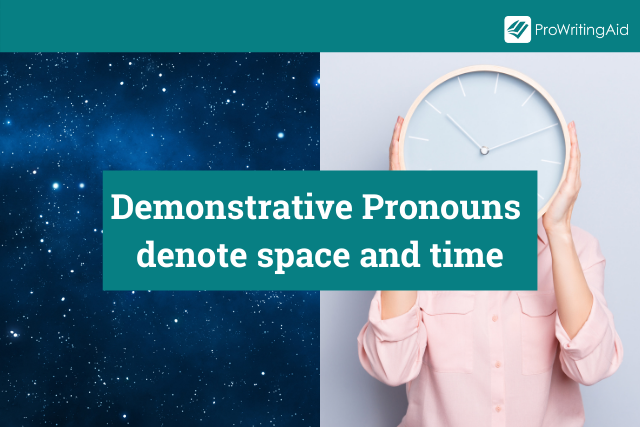
Demonstrative pronouns denote space and time. They replace nouns that have already been mentioned and identify something specific. Here’s the list of demonstrative pronouns:
- This
- That
- Those
- These
- Such
- None
- Neither
Let’s check out some sentences with demonstrative pronouns:
- Thank you for the Black Forest birthday cake. This is my favorite flavor.
- George is a talented footballer. That man blows my mind.
- I always listen to old speeches by Martin Luther King and Winston Churchill. Those were my favorite orators.
- Press the red and blue buttons. These will take you to paradise.
- Are you looking for perfection? Such doesn’t exist.
- Please do not bring me any food. I’m fasting, so I’ll eat none today.
- Cynthia doesn’t want a cat or a dog. Neither entertains her.
2. Personal Pronouns
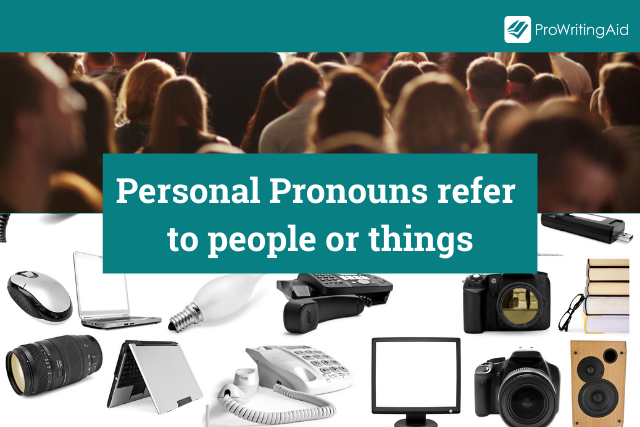
You use personal pronouns when you are talking about people or things. Personal pronouns refer to the person speaking, what they want, what they do, what is going on around them, and what’s being addressed.
The personal pronoun “I” refers to the speaker, while the word “you” can be used as both a subject pronoun (referring to someone else) and an object pronoun. The personal pronoun “you” is both singular and plural.
Let’s analyze this sentence:
- Do I have time for lunch?
You use the first-person singular here since you’re referring specifically to yourself. Next, check this out:
- Can you help Jane with her math problem?
This uses the second-person pronoun, because it’s referring to someone else.
The word “my” denotes what belongs to the speaker or what they are talking about, for example:
- My mom bought me this book last year.
Here’s a list of personal pronouns:
| I | He | We |
|---|---|---|
| Me | She | Us |
| You | It | They |
3. Possessive Pronouns
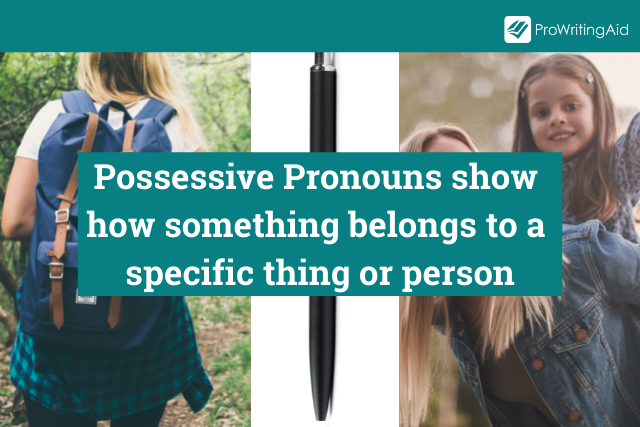
Possessive pronouns include mine, yours, and his. They show what belongs to or relates to a particular person. The thing with pronouns is they can belong to several categories. Possessive pronouns include some personal pronouns.
Here are some examples:
- I am her mum. (This sentence shows that the first word, “I,” belongs to what follows.)
- Your pen is black. (The second word, “pen,” belongs with what precedes it in this sentence.)
- You had better give me my bag back now! (In this example, the pronoun refers to what I have already mentioned—my bag.)
Here’s a list of possessive pronouns:
| My | Their | Mine |
|---|---|---|
| Our | Your | Yours |
| His | Its | Ours |
| Her | Hers | Theirs |
4. Indefinite Pronouns

Indefinite pronouns are not specific to what the pronoun is referring to. They don’t have an antecedent. Don’t worry; we’ll talk more about antecedents shortly.
Indefinite pronouns ending with -body represent people. And those ending with -thing denote things.
Examples:
- Everybody hates Chris.
- Something is bugging me.
- Everything looks awesome today.
- Is anybody home?
In negative clauses, use pronouns with no- and not any-.
- Nobody likes Chris.
- There’s nobody home.
Don’t use another negative when using clauses with no-.
- Nobody likes this weather. (NOT ~~Nobody doesn’t like this weather~~.)
- No one comes here. (NOT ~~No one does not come here~~.)
Here’s a list of indefinite pronouns:
| You | Somebody | None | More | Everything | Both |
|---|---|---|---|---|---|
| They | Some | Nobody | Many | Everyone | Anywhere |
| The other | Several | No one | Little | Everybody | Anything |
| Such | Other | Neither | Less | Enough | Anyone |
| Something | One | Much | Fewer | Either | Anybody |
| Someone | Nothing | Most | Few | Each | Any |
Here are more examples of indefinite pronouns in a sentence:
- Many are called, but few are chosen.
- All have sinned.
- Somebody has to pay for this.
- Everyone deserves to be happy.
- Everybody wants heaven, but nobody wants to die.
5. Relative Pronouns

Relative pronouns emphasize what is being talked about in a sentence. They include words like who, which, and that. These introduce relative clauses—clauses that tell us more about things and people.
Let’s check out a few relative pronouns.
- Who is often used with people’s names or titles
- Which refers to a place, animal, or thing that has already been mentioned in the sentence
- That denotes the person, thing, or animal just mentioned before this relative pronoun came into play
- What refers to a thing
Here’s a list of relative pronouns:
| That | Who |
|---|---|
| What | Whoever |
| Whatever | Whom |
| Which | Whomever |
| Whichever | Whose |
A few examples of sentences with relative pronouns include:
- The student who walks past my desk every day doesn’t say hi anymore.
- I was walking down the street when I saw what looked like a shooting star.
- The pen that you left on my desk yesterday isn’t there anymore!
- There goes the beautiful lady whom he loves.
- Peter seemed happy, which was unusual.
- Whoever created this formula is a genius.
- Whose phone is this?
- Whatever you do, don’t be afraid.
Fun fact:
In informal writing, you can leave out the relative pronoun when you’re using it as the verb’s object.
- Example with a relative pronoun: Paul is the person who I saw on TV.
- Example with no relative pronoun: Paul is the person I saw on TV.
6. Reflexive Pronouns
These are words that refer to the subject of a sentence. Reflexive pronouns end with -self. Plural forms end with -selves. They’re used when the subject does something to or by itself.
Here’s a list of reflexive pronouns:
- Herself
- Himself
- Itself
- Myself
- Oneself
- Ourselves
- Themselves
- Yourself
Let’s check out some sentences with reflexive pronouns:
- I hurt myself on Tuesday.
- They enjoy themselves on the beach.
- This new car drives itself.
7. Intensive Pronouns
These are similar to reflexive pronouns, but their primary function is to put more focus on a noun or another pronoun.
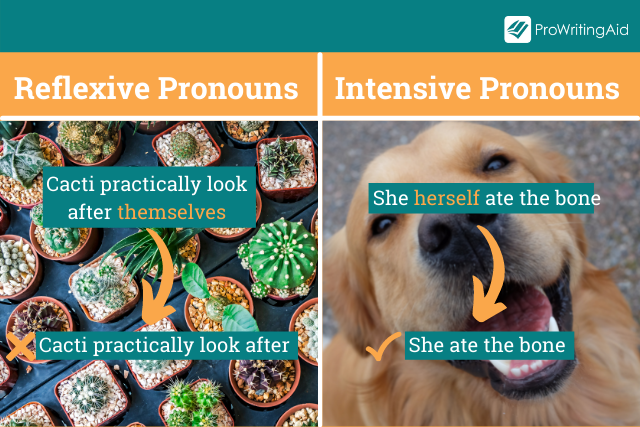
Use an intensive pronoun when you want to emphasize what the subject or object does, like in these examples
- She herself did it.
- The boss himself called me and said he would be here soon.
How do you tell the difference between a reflexive and intensive pronoun? Simple. A sentence can do fine grammatically without an intensive pronoun. But it won't make any sense without a reflexive pronoun.
Let’s take away the pronouns from the two examples above:
- She herself did it. → She did it.
- The boss himself called me and said he would be here soon. → The boss called me and said he would be here soon.
We can’t do the same with the examples on reflexive pronouns. Taking these away is incorrect:
- I hurt myself on Tuesday. → I hurt on Tuesday.
- This new car drives itself. → This new car drives.
So, if a sentence can be fine without the emphasizing -self word, then you’re using an intensive pronoun. If not, you’re using a reflexive pronoun.
Here’s a list of intensive pronouns:
- Herself
- Himself
- Myself
- Ourselves
- Themselves
- Yourself
- Yourselves
8. Interrogative Pronouns
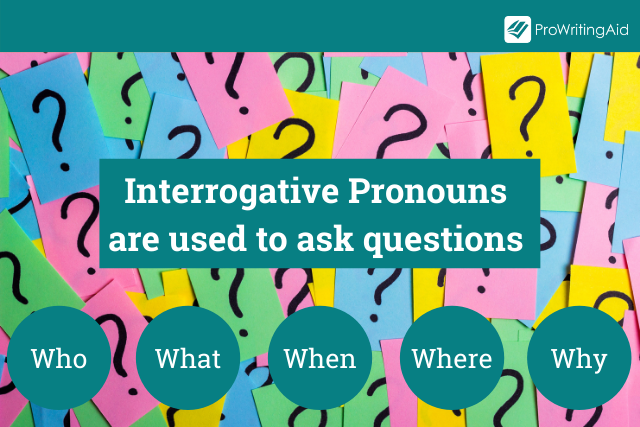
Interrogative pronouns help you to ask questions. These include words like who, what, and where. It’s easy to identify them since they all have that inquiry aspect.
There are five main interrogative pronouns. Here’s the list:
- What
- Which
- Who
- Whom
- Whose
Sometimes, more interrogative pronouns are created by adding the suffix -ever or -soever to the words above, e.g. whomever and whatsoever.
Let’s put interrogative pronouns in sentences:
- What do you want for your anniversary?
- Which phone did you buy?
- Whose book is this?
- Whom did you pay?
- Who won the soccer match?
9. Reciprocal Pronouns
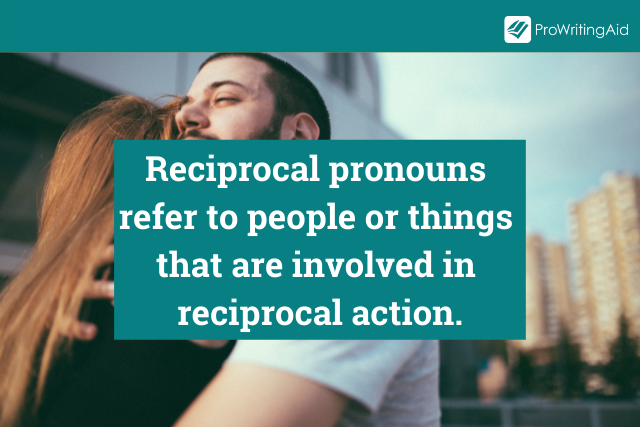
Reciprocal pronouns refer to people or things that are involved in reciprocal action. For example, “I like you” and “You like me too” both imply each person likes the other.
Reciprocal pronouns include:
- Each other
- One another
Yes, there are just two reciprocal pronouns that you can use in sentences like:
- If you keep fighting with one another, you’ll destroy each other.
- They loved each other so much that they got married in a spaceship.
Antecedents: What They Are and Why We Need Them
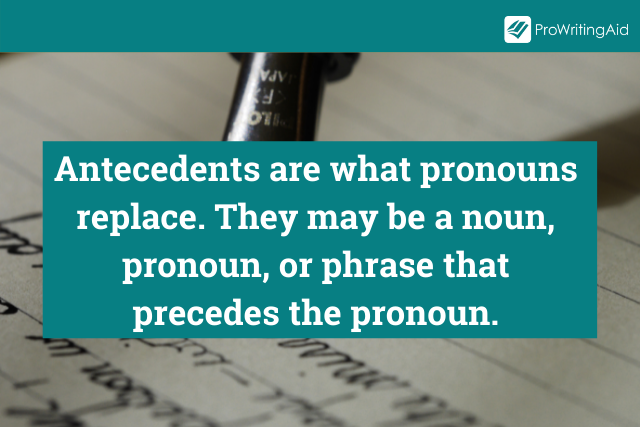
Pronouns can be confusing if you use them on their own. So, you use antecedents to make writing clearer. Antecedents are what pronouns replace. They may be a noun, pronoun, or phrase that precedes the pronoun.
You need to give a bit more context before someone can understand what you want the pronoun to replace—like what gender it is, for example. So, if you say “she” without having said anything else beforehand, people won’t know who exactly you’re talking about.
To avoid this problem, always precede pronouns with what they replace.
For example, Jane drinks too much. She may get into trouble if she keeps doing this. Here, “Jane” is the antecedent. So, if we use pronouns like “she” and “her” after that, it will be clear to readers that we’re all talking about dearest Jane who needs to cut back on drinking.
Frequently Asked Questions About Pronouns
You now have a clearer picture of pronouns and their usage. Here are answers to some frequently asked questions:
What Is a Pronoun?
A pronoun substitutes a noun or noun phrase to avoid repetition. It has an antecedent—what you’re substituting the word with. For example: John entered the coffee shop. He ordered his usual latte.
What Are Some Examples of Pronouns?
There are over 100 pronouns, and they all have slightly different uses. They include he, she, I, its, who, whom, which, somebody, something, myself, etc.
Why Do We Use Pronouns?
The main reason is to avoid wordiness. When you use a pronoun, it helps readers follow your text without unnecessary repetitions.
What’s the History of Pronouns?
Pronouns have been around for a long time. The earliest records come from the 1520s. Pronoun is derived from the Latin word prōnōmen, made from “pro” (substitution) and “nomen” (name).
Get Your Pronouns Right
Pronouns can be an absolute nightmare. They can confuse even some of the brightest minds. Not you, though. This article has broken it all down for you.
Use pronouns to increase your readability and conciseness. Proficient use of pronouns will make you a professional communicator. Yes, I deliberately used pro- thrice in the previous sentence to make the point stick. Here at ProWritingAid, we want you to be a pro.
Do you want to improve your entire writing experience? Do you want to make sure your grammar doesn’t give readers a headache? Use ProWritingAid as your writing assistant and mentor!